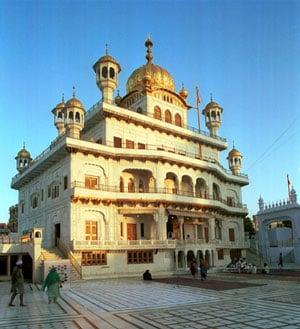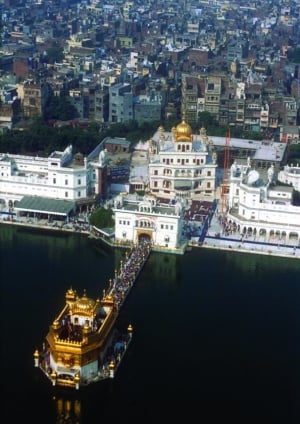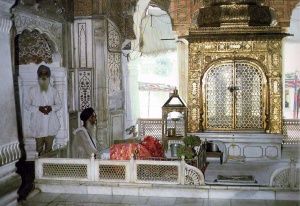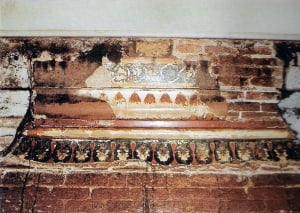Shri Akal Takhat
Akal Takhat: Throne of the Immortal
Akal Takhat means the Throne of the Immortal. The Akal Takhat was founded by Guru Hargobind on June 15, 1606 and was established as the place from which the spiritual and temporal concerns of the Sikh community could be acted upon. It is the most supreme of all the Takhats. (There are four takhats established by the Gurus: Amritsar, Anadpur Sahib, Patna Sahib, Hazur Sahib - and a fifth Takhat at Damdamma Sahib was established later.)
The Jathedar of the Akal Takhat is the highest spokesperson of the Sikh Panth and is meant to be a spiritual leader without control or influence from any outside, politically motivated sources.
There is no evidence to show exactly when the Akal Takht was built. From the amplitude of the near cantilever projection of the semi-circular platform onto a large square below, the throne of Akal seems to be a highly dramatised Durbar hall larger than that built by any Mughal Emperor in Delhi or Agra.
It is quite likely that, fighting from a temporal and spiritual kingdom placed in the heartland of Punjab in Amritsar, the Guru, who put on two swords, that of the faith and of the emergent Sikh kingdom, had it built to give audiences to his followers.
At any rate, the convention seems to have been established to address all important gatherings, religious, social and political, from the Akal Takht to the amphitheatre below. This became the practice certainly during the important Gurpurbs, or the birthdays of the Gurus, when a vast congregation would assemble to hear recitations from the scriptures. The elaboration of the structure on marble pillars, as a semi-circular platform with an open view to the courtyard, reminiscent of an air-house, must have grown from the use to which the Durbar hall was put.
The gilding of the ceiling with ornamentations like those in the interior of the Hari Mandir is perhaps later than in the holy of holies. The wall paintings apparently belong to a later period, as there are panels showing Europeans.
The total effect of the Akal Takht is of a unique and noble structure spread out somewhat like an outer court of the piazza Saint Marco in Venice.
Quotes about Akal Takhat
"It rightly faces the Golden Temple. Built by the Sixth Master Guru Hargobind (1606-44) in 1609, has been the nerve centre or the Sikhism ever since. All commandments affecting the community as a whole were and are issued from here. The Akal Takhat was used for holding court and Sikh congregations in the days of its builder.
The Akal Takhat was pulled down several times by the Muslim raiders. The ground floor of the present building was constructed in 1 874. Three storeys were subsequently added by Maharaja Ranjit Singh. A number of weapons used by Guru Hargobind, Guru Gobind Singh and other Sikh heroes are preserved at Akal Takhat. In 1984 during Operation Blue Star Akal Takhat was badly damaged by the Indian Army. "
- Above quote from: [www.sgpc.net]
"Akal Takhat grew into an institution which symbolized in itself the idea that the use of sword for the protection of righteousness and for self-defence was called for. Here the Guru sitting on his throne, would watch wrestling bouts and military feats of his disciples performed in the open arena opposite to the Akal Takhat. As all intricate cases and disputes were finally decided here by the Guru, the Akal Takhat served the purpose of a Supreme Court for the Sikhs. Besides throne, the Guru adopted all other emblems of royalty- the umbrella, the swords, the crest and the hawk, and thus the Sikhs called him a true king or 'Sacha Padshah'- a king in all appearance but in deeds and in purity as holy and great as previous Gurus. People looked towards Akal Takhat for guidance in their secular affairs. This custom became so significant that the decision once taken at Akal Takhat was followed by the Sikhs enthusiastically and this was the reason that they were always able to overcome every peril. The development of this custom contributed a lot towards the consolidation of the Sikh Movement."
- Above quote from: [www.allaboutsikhs.com]
"[In] 1920 Sri Akal Takhat came under Panthic control of Shiromani Gurudwara Prabandhak Committee. Bhai Teja Singh of Bhuchar made a suddden swoop on the Akal Takhat and took possesion of the shrine.
==> AKAL TAKHAT - an institution, initially named Akal Bunga, established by Sri Guru Hargobind Sahib in sunmat 1665 for Sikh Governance, located in front of Harmindar Sahib, Amritsar. Regular diwans were conducted daily, during early morning and evening by Guru Sahib. AkalBunga, represents the centre for all Panthic jathaebandia (groups). It is where Gurmat resolutions are announced and procalamations made that are binding to all Sikhs around the world. Akal Bunga is the first Takhat for Sikhs and hence popularly known as Akal Takhat. Some of the arms preserved at this location include:
- 1. Sri Sahibs (swords) of Guru Hargobind Sahib that represented Miri and Piri
- 2. Sri Sahib (sword) of Guru Gobind Singh Ji
- 3. Sri Sahib (sword) of Baba Buddha Ji
- 4. Sri Sahib (sword) of Bhai Jaetha Ji
- 5. Sri Sahib Baba Karam Singh Ji Shaheed
- 6. Sri Sahib Bhai Uday Singh Ji, who was with Guru Gobind Singh Ji
- 7. Sri Sahib Bhai Bidhi Chand Ji
- 8. Dudhara Khanda (double-edged sword) of Baba Gurbakash Singh Ji Shaheed
- 9. Dudhara Khanda (double-edged sword) of Baba Deep Singh Ji
- 10. Dudhara Khanda of Baba Nodh Singh Ji Shaheed
- 11. Khadag Bhai Vachitar Singh Ji which weighed 10 Saer
- 12. Guru Hargobinds Sahib's "Guraj" weighing 16 saer. It was given to Dharamvir Jassa Singh by Matta Sundari
- 13. A sword like weapon belonging to Guru Hargobind Sahib Guru Hargobind Sahib's Katar
- 14. Baba Ajit Singh's Katar
- 15. Baba Jujhar Singh's Katar
- 16. Guru Hargobind Sahib's kirpan
- 17. Guru Hargobind's Paeshkabaj
- 18. Baba Deep Singh's Paeshkabaj
- 19. A sword like weapon of Baba Deep Singh Ji Shaheed
- 20. Pistol of Baba Deep Singh Ji Shaheed
- 21. Two arrows of Guru Gobind Singh each cxontaining one Toala of gold
- 22. Medium sized Khanda of Baba Deep Singh Ji
- 23. Two kirpans of Baba Deep Singh Ji
- 24. Two small Khandas of Baba Deep Singh Ji
- 25. Chakar Of Baba Deep Singh Ji
- 26. Small Chakar of Baba Deep Singh Ji
- 27. Baba Deep Singh Ji's chakar for head decoration
-Ref. Mahan Kosh (pp. 36)
- Above quote from: [www.allaboutsikhs.com]
References
- Singh, Patwant (1989). The Golden Temple. South Asia Books. ISBN 9627375012.
- edited by Kavita Singh (2003). New Insights into Sikh Art. Marg Publications. ISBN 8185026602.


![]](/images/thumb/8/8c/Img0004.jpg/200px-Img0004.jpg)


